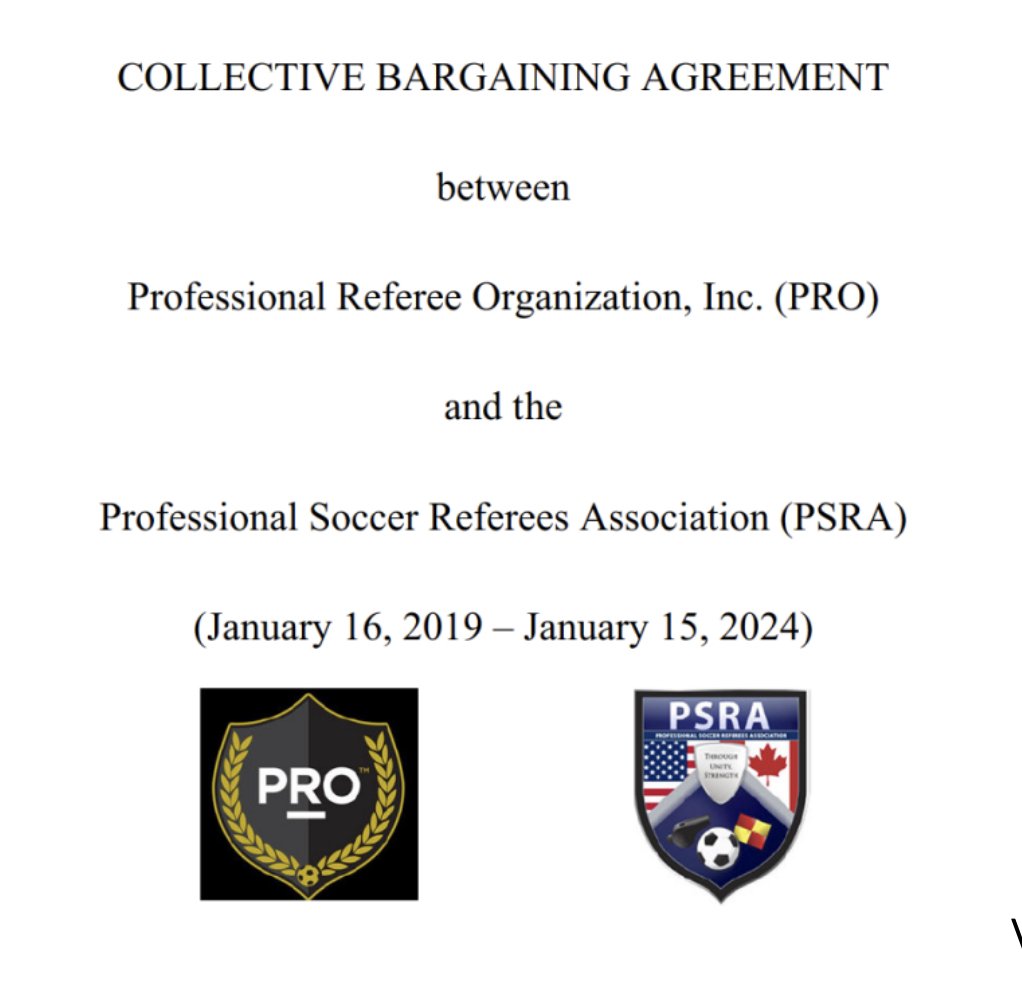The Post Dives Into the Refs’ Collective Bargaining Agreement
Grayson
Part One: Referee Compensation
With recent debates over who FC’s biggest rivals are (Columbus? Lou City? NYRB? Definitely not Nashville), one has slipped through the cracks – Professional Referee Organization, Inc. (“PRO”), the organization that employs MLS officials. Or maybe, now that the FC holds an early but meaningful lead in the Supporters’ Shield race, referee influence over the game is simply not that important.* But it’s striking how little attention is paid – outside of the 90-minute game, of course – to this group of people who have such an impact over our favorite team.
*Of course, that lead would be larger if Lucho had been correctly awarded a second-half penalty against New England.
When the MLS Players’ Association released the player salaries a few weeks ago, it was an opportune time to remember that the referees also belong to a union. But while the MLSPA publishes player salaries twice a year and also publishes a copy of the current and previous labor agreements, very little reliable information about referees is publicly available. Even basic stuff like how referees are paid and evaluated is held behind a veil of secrecy.
Until now.
The Post has obtained a copy of the labor agreement between PRO and the referees’ union, Professional Soccer Referees Association (“PSRA”), that by its terms was in effect from January 16, 2019 to January 15, 2024. In a series of articles, The Post will discuss various aspects of the labor agreement, starting today with the topic of referee compensation.
Unless specified otherwise, the information provided comes directly from the labor agreement. These things can be amended from time to time, however, so it’s always possible that actual practice is slightly different. Nevertheless, the 2019 labor agreement offers fans the first opportunity for a detailed look at the framework under which MLS referees operate.
But first, it’s probably best to start with one question:
What is PRO anyway?
PRO was founded in 2012, set up jointly by MLS and the United States Soccer Federation (“USSF”). PRO’s website does not provide a lot of information about its history. However, in 2019 Paul Rejer – PRO’s former Director of Training and Education – filed an age discrimination lawsuit against PRO, and the documents associated with that lawsuit contain some significant details about PRO’s history and operations.
The chief executive of PRO is its General Manager, currently Howard Webb. According to an affidavit filed in the lawsuit by Webb, the General Manager is hired by PRO’s board of directors, which has five members: (1) two directors appointed by MLS, (2) two directors appointed by USSF, and (3) one director appointed by the other board members.
According to a document filed by Rejer, and summarized by the court in an order, PRO’s offices are located in MLS’s offices and PRO shares MLS’s human resources and IT departments. Rejer also claimed that MLS provides 80 percent of PRO’s funding, and that MLS negotiated and approved the labor agreement between PRO and PSRA. (MLS did not appear to directly dispute these allegations in any of the filings in the lawsuit, but it is possible that they are not fully accurate. Even if MLS is not itself party to the labor agreement between PRO and PSRA, MLS very possibly participated in the negotiations.)
It is not clear how much money MLS spends to support PRO. USSF, however, makes its financial statements available each year. USSF’s financial statements confirm that MLS and USSF are the two members of the LLC agreement governing PRO, which “provides for an annual contribution based on a percentage of defined Shared Expenses, subject to a cap.” USSF’s financial statement for the fiscal years ending March 31, 2013 and 2012 clarifies that at least initially USSF held a 25% stake in PRO, and that the LLC agreement had an initial term of five years with an option to extend an additional five years. (If anyone has a copy of this agreement and wants to pass it along, The Post will happily accept one.) Further, during the fiscal year ending March 31, 2017, USSF’s board approved funding for the Video Assistant Referee (“VAR”) program for the 2017-2018 professional season. USSF’s most recently available financial statement states that USSF incurred $1,836,322 of expenses related to PRO and VAR in the fiscal year ending in March 31, 2022.
Fine, but Tell Us About the Money!
It is obvious what you sickos want, but first is a disclaimer that the information in this labor agreement relates solely to those officials who are covered by that agreement (referred to in the agreement as capital-O “Officials”). “Officials” is defined as “all persons employed by PRO as match Referees, Assistant Referees, Video Assistant Referees … and/or Assistant Video Assistant Referees … under the terms of this Agreement and who are members of the bargaining unit.” Essentially, these Officials are the ones employed by PRO to officiate MLS games.
The Recognition Clause (which defines the bargaining unit) says that the labor agreement does not apply to officials used to cover for emergency situations and officials employed on a tryout basis (although those officials might be covered by another agreement, such as the one that applies to PRO2 officials). However, the clause also says that any “tryout” officials automatically become part of the bargaining unit once they have worked their 10th MLS Regular Season Match in one season. PRO can also hire tryout officials full-time before their 10th game in a season, in which case they will immediately become a member of the bargaining unit. The labor agreement also places limits on how often PRO can assign non-PSRA Officials to MLS matches.
Last year, the PSRA also became the official bargaining representative for officials in PRO2, a level of referees that provides officials primarily for NWSL and USL matches (occasionally, PRO2 officials will also staff MLS matches). A collective bargaining agreement was ratified by the PRO2 member referees in Tiers A, B, and C last month, but The Post has not obtained a copy of that agreement. (PRO2 referees in Tier D are considered in the “training tier” and were not included.)
OK but What About the Money?
Compensation is primarily driven by an Official’s category of employment. Under the labor agreement, Officials are separated into four categories: Referees, Assistant Referees, VARs, and AVARs. In each case, those categories are further divided into “Probationary” and “Non-Probationary” employees. “Probationary” employees are those with less than two full years of service in their category. A full year of service in a category is one in which the Official: “(i) is employed as an Official in the relevant category of employment during the MLS Regular Season and has officiated at least five (5) MLS Regular Season Matches during that Season; or (ii) is employed as an Official in the relevant category of employment prior to the start of the MLS Regular Season.”
Referees and Assistant Referees are paid in two primary ways: Salary and Match Fees. Salaries vary by category, by whether the Official is Probationary or Non-Probationary, and by how many matches the Official has worked. Probationary employees receive the same salary regardless of how many matches they have officiated. Non-Probationary employees receive a graduated salary based on the following Match counts: 0-99, 100-149, 150-199, and 200+.
VARs and AVARs are paid a little differently. They receive a retainer based on whether they have a match count of either 0-49 or 50+.
For the 2023 season, the labor agreement provides for the following Official salaries (numbers are on an annual basis, but they are paid out periodically as salary):
In addition, Officials receive Match Fees. Match Fees vary based on category, league, and type of match (regular season, playoff, semi-final, MLS Cup, or All Star game). (There are also lower Match Fees set for NWSL, Division 2, and Division 3 matches, but for the sake of simplicity only MLS fees are included.)
The MLS Match Fees specified in the labor agreement for 2023 are:
In MLS Cup and the All-Star game, Reserve Assistant Referees are also employed at a lower Match Fee.
The agreement guarantees that Referees, Assistant Referees, and VARs will be offered a minimum of 10 Regular Season Matches a season. AVARs are offered a minimum of five Regular Season Matches a season. (Officials who join the bargaining unit mid-year receive a pro-rated guarantee, based on the date they joined. Matches worked before joining the bargaining unit, however, do not count against this guarantee.)
However, under the labor agreement Assistant Referees do not receive a Match Fee for an MLS Regular Season Match until their 11th assignment as an MLS AR in a season. This limitation does not apply to Match Fees for NWSL or men’s lower-division games, and Assistant Referees receive Match Fees for all playoff or All-Star game assignments.
Referees receive medical insurance for themselves with premiums fully paid for by PRO, and family coverage premiums 90 percent paid by PRO. Assistant Referees, VARs, and AVARs have the option to select medical coverage, but they are responsible for 100 percent of their premiums.
Referees and Assistant Referees also may participate in a 401(k) Plan. Referees get 100 percent matching of their contributions up to 3.5% of their gross earnings each year; Assistant Referees get matching of up to 2% of their gross earnings.
Parental leave is provided for Officials – both paternity and maternity leave. Officials get two months of paternity leave at 100% pay. Officials get three months of maternity leave at 100% pay, then three months of maternity leave at 50% pay, and no pay for months of leave beyond six months.
Finally, Officials receive certain other travel benefits, incidental compensation such as an allotment for gym membership, payments for attending training, bonuses for officiating more than a certain number of games, and a severance pay formula. Some of those include:
To sum up, take the example of a Non-Probationary referee with a Match count of 20 to start the season. Adding the Official’s base salary together with her 10-game minimum comes to minimum annual compensation of $107,105.49 – that’s Roman Celentano money! And before incidental compensation and benefits are included.
Are Assistant Referees, VARs, and AVARs Kind of Getting Screwed on Pay?
I don’t know. Maybe? Referees have a lot more responsibilities, and not just on match days, which will be explored in future articles. Given the additional Referee responsibilities, it may be difficult to keep up another full-time job. Referees and Assistant Referees also have different fitness standards they must pass, and Referees are required to participate in a Sport Science Program (which is optional for Assistant Referees).
In any case, the most important point is that these are collectively bargained pay and benefits, so it’s not really my place to second guess what the union has agreed to.
So What’s Next?
Future posts will discuss fitness standards, performance evaluations, and other items of interest raised in the labor agreement. It is a dense, detailed document, and one article on it would either be way too long for anyone to read or too light on detail to provide meaningful information.
But, here’s one more fun thing to close on – Article XXI is entitled “Public Criticism of Officials.” That article is short: “PRO and the PSRA agree to work collaboratively to try to eliminate significant unwarranted public criticism of PRO Officials or their officiating.” So just think about that, and what it means, while you wait for the next installment.






